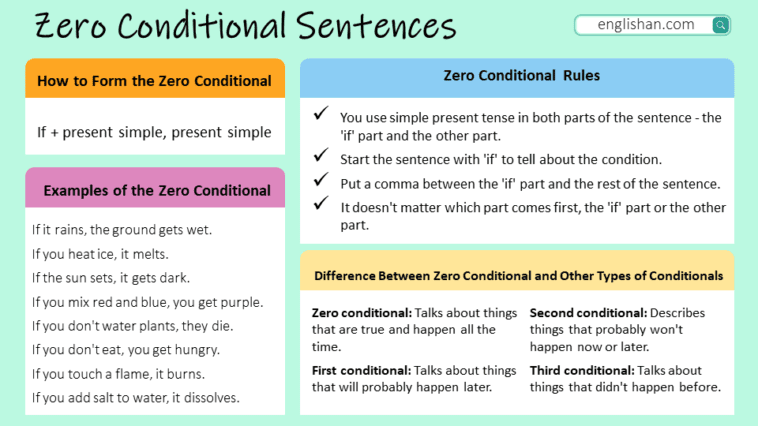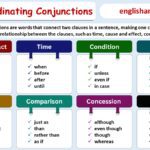A zero conditional sentence is a way of expressing things that are always true or habitual in English. It follows a simple structure, using the present simple tense in both parts of the sentence. This type of construction is commonly used for stating general truths, facts, or recurring situations. In a zero conditional, the if clause introduces a condition, and the main clause presents the result, with the understanding that the connection between the two is consistent and universally true.
Structure of a Zero Conditional Sentence
The structure of a zero conditional sentence consists of two main components: the “if” clause (introducing the condition) and the main clause (expressing the result). Here’s the basic structure:
If + present simple tense, + present simple tense.
- If Clause:
This part begins with “if and introduces the condition. It typically uses the present simple tense.
Examples:
- If it rains, the ground gets wet.
- If you heat ice, it melts.
- If the sun sets, it gets dark.
- If you mix red and blue, you get purple.
- If you don’t water plants, they die.
- If the temperature drops below freezing, water turns into ice.
- If you don’t eat, you get hungry.
- If you touch a flame, it burns.
- If you add salt to water, it dissolves.
- If you turn off the lights, the room becomes dark.
- If you press the button, the machine starts.
- If water reaches 100 degrees Celsius, it boils.
- Main Clause:
This part expresses the result or consequence that consistently follows the condition.
Example:
- If it rains, the ground gets wet.
- If you heat ice, it melts.
- If the sun sets, it gets dark.
- If you mix red and blue, you get purple.
- If you don’t water plants, they die.
- If the temperature drops below freezing, water turns into ice.
- If you don’t eat, you get hungry.
- If you touch a flame, it burns.
- If you add salt to water, it dissolves.
- If you turn off the lights, the room becomes dark.
- If you press the button, the machine starts.
- If water reaches 100 degrees Celsius, it boils.
Characteristics of Zero Conditional Sentences
The characteristics of zero conditional sentences are:
1. Universality:
Zero conditionals express general truths, facts, or situations that are universally true or consistently applicable.
- Example: If you mix red and blue, you get purple.
- Explanation: This sentence expresses a universal truth that mixing red and blue always results in the color purple.
2. Present Simple Tense:
Both the If Clause (condition) and the Main Clause (result) use the present simple tense. This reinforces the idea that the condition and result are regularly and predictably connected.
- Example: If it rains, the ground gets wet.
- Explanation: Both the If Clause and the Main Clause use the present simple tense, emphasizing the regularity of the relationship.
3. Cause-and-Effect Relationship:
Zero conditionals establish a clear cause-and-effect relationship, where a specific condition reliably leads to a particular consequence.
- Example: If you touch a flame, it burns.
- Explanation: This sentence establishes a clear cause-and-effect relationship where touching a flame always results in burning.
4. Lack of Speculation:
Zero conditionals are used for situations that are factual and certain, not for hypothetical or speculative scenarios.
- Example: If water reaches 100 degrees Celsius, it boils.
- Explanation: The statement is factual and certain, describing a scientific fact rather than a hypothetical situation.
5. Everyday Truths:
They are often used to describe everyday truths, scientific principles, natural laws, or habitual actions.
- Example: If you don’t water plants, they die.
- Explanation: This sentence reflects an everyday truth that neglecting to water plants consistently leads to their death.
Application and Usage Notes for Zero Conditional Sentences
Contexts where zero conditionals are commonly used
1. Everyday Truths:
Zero conditionals are commonly used to express everyday truths and situations that are consistently true.
- Example: If it rains, the streets get wet.
2. Scientific Statements:
They are suitable for expressing scientific principles, laws, or facts.
- Example: If you mix hydrogen and oxygen, you get water.
3. Universal Facts:
Zero conditionals are effective for conveying universally accepted facts.
- Example: If the Earth revolves around the sun, it experiences seasons.
4. Habitual Actions:
These sentences can describe habitual actions and their predictable outcomes.
- Example: If she doesn’t drink coffee in the morning, she gets a headache.
5. Instructions and Procedures:
Zero conditionals are used to provide instructions or describe procedures based on consistent outcomes.
- Example: If you follow the recipe, the cake turns out delicious.
Distinction from Other Conditional Structures
1. Zero vs. First Conditional:
Zero conditionals express general truths, while first conditionals deal with real and possible future situations.
- Zero: If water reaches 100 degrees Celsius, it boils.
- First: If it rains tomorrow, we will stay indoors.
2. Zero vs. Second Conditional:
Zero conditionals state general truths, whereas second conditionals deal with hypothetical or unlikely situations in the present or future.
- Zero: If you touch a flame, it burns.
- Second: If I won the lottery, I would travel the world.
3. Zero vs. Third Conditional:
Zero conditionals express general truths, while third conditionals refer to hypothetical situations in the past.
- Zero: If you heat ice, it melts.
- Third: If she had studied harder, she would have passed the exam.
1. Factual Statements:
Zero conditionals are ideal for expressing factual statements, scientific facts, or universally accepted truths.
- Example: If you mix red and blue, you get purple.
2. Generalizations:
They are commonly used for making generalizations about cause-and-effect relationships that are consistently true.
- Example: If you water plants regularly, they thrive.
3. Instructions and Guidelines:
Zero conditionals are suitable for providing instructions or guidelines based on regular cause-and-effect patterns.
- Example: If the recipe calls for baking soda, the cake rises.
Variations in Zero Conditional Form
While the basic structure of zero conditionals involves using the present simple tense in both the if clause (condition) and the main clause (result), there can be variations in the form to add nuance or specificity. Here are a few variations:
1. Imperative in the Main Clause:
- If you water plants, they thrive.
- Explanation: Here, the main clause is in the imperative form, providing a directive or instruction based on the condition.
2. Modal Verbs in the Main Clause:
- If you heat ice, it can melt.
- Explanation: Modal verbs like “can” can be used in the main clause to indicate possibility or probability.
3. Additional Phrases for Emphasis:
- If it rains, the ground invariably gets wet.
- Explanation: Adding adverbs or phrases like “invariably” can emphasize the consistency of the relationship.
4. Time Adverbs or Adverbial Phrases:
- If you mix red and blue, you always get purple.
- Explanation: Including time adverbs like “always” can emphasize the perpetual nature of the condition.
How to Identify Zero Conditional Sentences
Identifying zero conditional sentences involves recognizing specific characteristics and structural elements.
- Look for a structure with if + present simple tense in both the if clause and the main clause.
- Example: If it rains, the ground gets wet.
- Check for statements expressing universal truths, facts, or consistent cause-and-effect relationships.
- Example: If you touch a flame, it burns.
- Observe the use of the present simple tense, indicating certainty and regularity.
- Example: If water reaches 100 degrees Celsius, it boils.
Common Mistakes to Avoid with Zero Conditional Rules
When using zero conditional rules, remember these key points to avoid common mistakes:
- Stick to the simplicity of the present simple tense in both the “if” clause and the main clause.
- Avoid introducing past or future tense, maintaining consistency for accurate communication.
- Refrain from using speculative language or introducing uncertainty in the main clause, as zero conditionals express certainty.
- Reserve zero conditionals for situations that are consistently and universally true, avoiding hypothetical or future scenarios.
- Ensure a clear and direct cause-and-effect relationship without unnecessary complexity in sentence structures.
Quiz:
- If you mix red and blue, what color do you get? a. Green b. Purple
- What does water do when you heat it to 100 degrees Celsius? a. Freezes b. Boils
- If you touch fire, what happens? a. It turns blue b. It burns
- Finish the sentence: If it snows, the ground ___________. a. Is wet b. Gets wet
- What tense is used in both the “if” clause and the main clause of a zero conditional? a. Present simple b. Past simple
- What adverb can emphasize the certainty of a zero conditional? a. Sometimes b. Always
- If you don’t water plants, what typically occurs? a. They grow faster b. They die
- What happens if you add salt to water? a. It evaporates b. It dissolves
- Complete the sentence: If you press the button, the machine ____________. a. Stops b. Starts
- If the sun sets, what happens? a. It rises again immediately b. It gets dark
- In zero conditionals, what kind of relationship is established between the “if” clause and the main clause? a. Hypothetical b. Cause-and-effect
- If you don’t study for exams, what might happen? a. You pass with flying colors b. You fail
- What is the primary purpose of zero conditional sentences? a. Expressing uncertainty b. Conveying universal truths
- If you touch dry ice, what occurs? a. It becomes wet b. It burns your skin
- What does ice do when you heat it? a. Melts b. Freezes
Answers:
- b. Purple
- b. Boils
- b. It burns
- b. Gets wet
- a. Present simple
- b. Always
- b. They die
- b. It dissolves
- b. Starts
- b. It gets dark
- b. Cause-and-effect
- b. You fail
- b. Conveying universal truths
- b. It burns your skin
- a. Melts
FAQS:
- What is a zero conditional sentence?
- A zero conditional sentence is a grammatical structure used to express universal truths, facts, or cause-and-effect relationships that are consistently and always true. It is formed with the present simple tense in both the “if” clause (condition) and the main clause (result).
- When should I use zero conditionals?
- Use zero conditionals to describe situations or facts that are universally true, habitual actions, scientific principles, or everyday truths where a specific condition reliably leads to a predictable result.
- What is the structure of a zero conditional sentence?
- The basic structure includes an “if” clause followed by a main clause, both using the present simple tense. For example: If [condition], [result].
- Can zero conditionals express hypothetical situations?
- No, zero conditionals are not used for hypothetical or speculative scenarios. They are reserved for situations that are consistently and universally true.
- How do zero conditionals differ from other conditional types?
- Zero conditionals differ from other conditionals by expressing general truths in the present, whereas other conditionals (first, second, and third) deal with present, future, or hypothetical situations.
- What common mistakes should I avoid when using zero conditionals?
- Common mistakes include using incorrect verb tenses, introducing speculative language, neglecting the present simple tense, and applying zero conditionals to hypothetical or future scenarios.
- Are there exceptions to using zero conditionals?
- Zero conditionals are generally straightforward, but it’s essential to consider the context. In some cases, alternative conditionals might be more suitable based on the specific nuance you want to convey.
You May Also Like
- Clauses and their Types with Examples
- Coordinating Conjunctions Definition, Rules, Usage, and Examples
- Conjunctions Worksheet with Answers in Examples
- Zero Conditional Worksheets with Answers in English
- First Conditional Sentences With Examples
- Third Conditional Sentences with Examples
- Second Conditional Sentences with Examples



